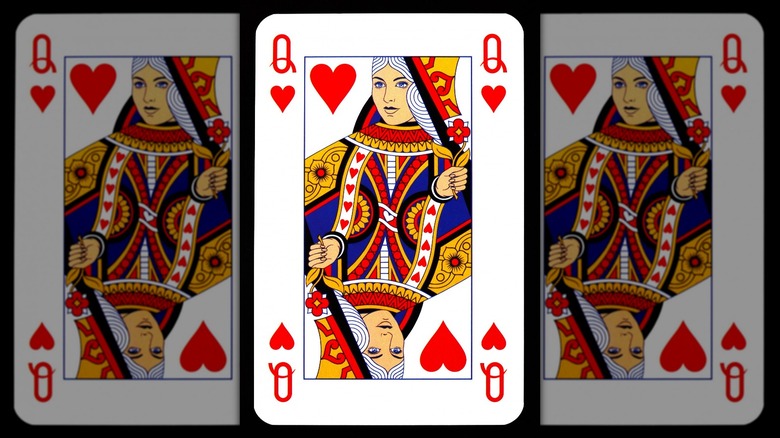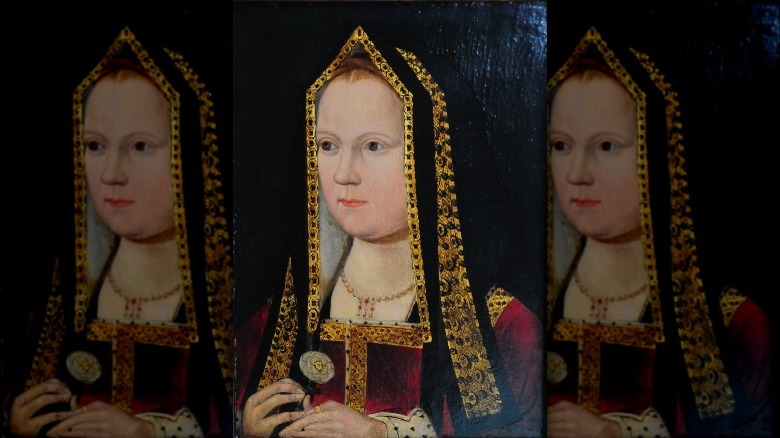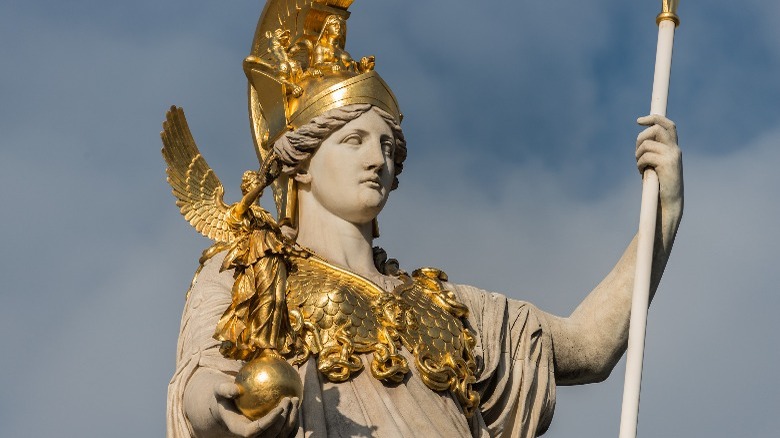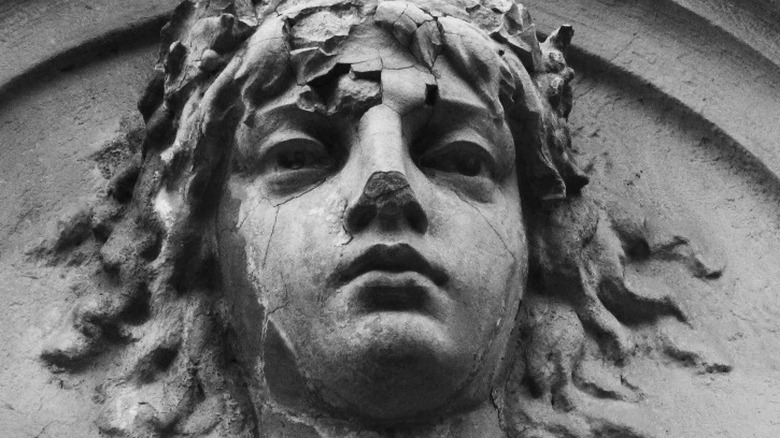Why Are There Queens On Playing Cards And Who Are They Said To Be?
You know the standard deck of cards: 52 cards, black and red numbers and symbols in the corner of each, and colorful drawings of kings and queens, along with the jacks. How did the design of these cards come about? How did the queens end up there?
Playing cards as we know them date back hundreds of years, at least to the 14th century, when they were banned in France on work days so as not to cause distractions. Their provenance is older than that and has been lost to time. They probably came to Europe from an Eastern culture. For a long time, the design of the cards wasn't standardized, and different regions had their own. German and Spanish cards didn't have queens at all, replacing them with knights (via The Atlantic).
Paul Bostock, a council member of the International Playing Card Society, told The Atlantic that before card designs became uniform, the choice of suits in a card deck was controlled by whichever noble family commissioned them to be made. We can extrapolate from this that the nobility may have influenced the pictures on the cards, too, filling them with upper class figures. But just who are those figures?
The Elizabeths
Possibly because England standardized the playing card designs we know today, per Playing Card Decks, two English princesses have been suggested as models for the Queen of Hearts. Elizabeth Stuart was the daughter of King James I of England and Anne of Denmark. She later became Queen of Bohemia (in the modern Czech Republic), but she and her husband only reigned for a few cold months, earning her the nickname "the Winter Queen."
That wasn't her only nickname, however, according to Westminster Abbey's website. She was also called "the Queen of Hearts" because she was beautiful, charming, and brave in the face of danger when she and her husband were deposed. Thus, she's been proposed as an inspiration for the playing card character (via "The Real Personages of Mother Goose," posted at Hathi Trust Digital Library).
Another possible inspiration is Elizabeth of York, who was the mother of King Henry VIII and Elizabeth Stuart's great-great-great grandmother. She loved playing cards, so it's been suggested that when she died, her husband immortalized her by designing the Queen of Hearts to look like her. Though the standard version of the Queen of Hearts looks a lot like a famous portrait of Elizabeth of York (above), England Cast concludes that based on timelines, the story probably isn't true.
Rachel
Though modern cards aren't labeled with names, French playing cards were, between the 16th and 18th centuries (via Playing Card Decks). The two different French card patterns (Paris and Rouen) had different names for the queens, according to the International Playing Card Society. In the Rouen pattern, which eventually became the English and American pattern, they were Rachel (hearts), Pallas (spades), Argine (diamonds), and Judith (clubs).
So were they named after real people? The truth is, no one knows for certain, but there are plenty of theories about each one (via The Guardian). Rachel, the original Queen of Hearts, has been associated with Ragnel, wife of Sir Gawain in the Arthurian legends, according to Playing Card Decks. Another theory from The Guardian: she's Agnés Sorel, mistress of King Charles VII of France. However, there's no obvious link between the two, except that Agnés lived in France from 1421-1450 just before the cards would have been named (via Museum Facts).
Usually, though, she's identified as the Biblical Rachel, Jacob's wife (above right), according to Playing Card Decks.
Pallas
The Guardian says Pallas, the Queen of Spades, can be identified with the Greek goddess Athena, who was also sometimes called Pallas. However, The Guardian also suggests Joan of Arc as a possibility, presumably because she was another important French figure of the 1400s.
In Greek mythology, Athena was the goddess of war. She was associated with several different cities, such as Sparta and Athens, which is named for her, because she was their protector. She's been linked to different acropolises, probably because they were located near kings' palaces (via Britannica). Athena was extremely powerful because she was Zeus' favorite child. As the goddess of war, she plays a large role in Homer's "Iliad," an account of the Trojan War.
In her less martial moments, Athena was also a patron goddess of handicrafts like spinning and weaving. She eventually became a symbol of wisdom and righteousness. Britannica associates her other names, Pallas and Parthenos, with her representation of virginity. Athena was never known to have had a spouse or children.
Argine
Argine is the Queen of Diamonds, and Playing Card Decks says her name may simply be an anagram for Regina, which means queen. However, the site also suggests Princess Argeia of Argos as her inspiration. In Greek mythology, Argeia is the daughter of Adrastus, king of Argos. According to the University of Pennsylvania's classics department, Adrastus gives Argeia in marriage to Polyneices, son of Oedipus, to fulfill a prophecy.
The Guardian identifies Argine with another figure from Greek mythology, the goddess Hera (known as Juno in Roman mythology). She was queen of the gods as Zeus' wife. Hera was the patron goddess of the city of Argos, which may explain her name on the cards (via Britannica).
The Guardian's other suggestion for the Queen of Diamonds' identity is Mary of Aragon, wife of King Charles VII of France (the king who was assisted by Joan of Arc), thus tying the cards back to 15th-century French figures. The Guardian may be confusing Mary with her mother, Yolande of Aragon. Mary was from Anjou.
Judith
Both The Guardian and Playing Card Decks suggest the previous queen of France, Isobel of Bavaria (shown above entering Paris), as the inspiration for Judith, Queen of Clubs. She was the wife of King Charles VI and mother of Charles VII. Also known as Isabeau or Isabella, she was a controversial figure. Her husband was insane, and she ruled in his stead, but with many noblemen opposing her. One, Duke Louis of Orleans, became her lover, causing a scandal. She also signed the unpopular Treaty of Troyes, ceding the throne of France to the English king Henry V (this would later be invalidated) (via Encyclopedia.com).
More in line with the name of the Queen of Clubs, Holy Roman Empress Judith has also been suggested. She, too, was embroiled in power struggles during her time, as she fought for her son to become the next emperor. She, like Isobel, was from Bavaria, Germany, per Encyclopedia.com.
The third theory is that Queen Judith is the Biblical Judith, who saves Israel from being invaded by the Assyrians by killing an Assyrian general, Holofernes. The Book of Judith is deuterocanonical, being included in Catholic and Orthodox versions of the Old Testament, but not in Protestant or Jewish versions (via New World Encyclopedia). Whatever the original sources of the names, the theories show how much Biblical, mythological, and historical figures have influenced Western culture.





